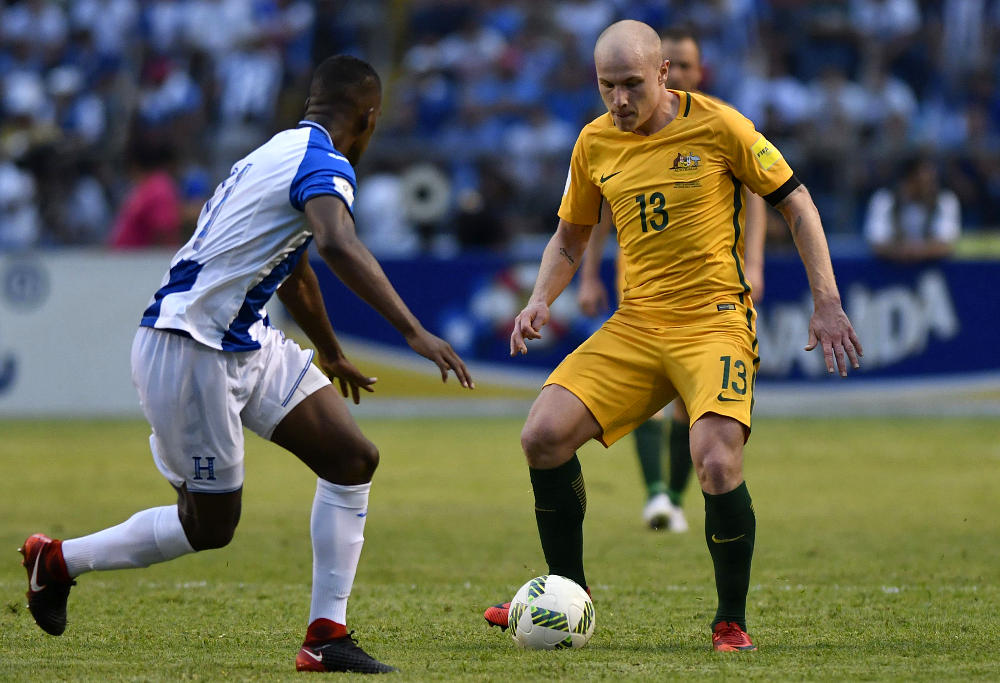Managers rarely deviate too dramatically from their rusted-on tendencies.
Over the course of a World Cup, it becomes even more important to maintain consistency; a small bundle of pressurised games, coming in quick succession, contested by teams that probably haven’t had more than a few weeks to gel.
Managers, sensing this pressure, invariably retreat back into tried and trusted methods. This is particularly true for new managers, like Bert van Marwijk, who are taking new teams into the heat of battle; they have to prepare them quickly and efficiently, and there’s little room for risky tactical improvisation.
The 26-man squad – to be trimmed again by three before the big tourney – announced by van Marwijk on Tuesday sent impassioned observers spinning wildly like dervishes, frenzied and frothing at Jamie Maclaren’s omission. They are right to be outraged, at least a little.
A lot of the carrying-on has been exacerbated by Tim Cahill’s inclusion – pouring petrol on the fire, appropriately enough – not that that in and of itself should be particularly galling. No, it’s Maclaren’s exclusion combined with the truly ghastly ‘Cahilltex’ marketing campaign, a project that must have been brainstormed – a real meeting of the minds that would have been – ironed out, and mobilised months ago, when the final World Cup squads were months away from being established.
It was then erected on Monday, launched during Tuesday’s announcement, a clanging – and not entirely atypical – bit of timing from the FFA and their major sponsor. Anyone with two synapses to rub together could have told you Cahill’s inclusion, having played an hour of football since January, was going to cause a ruckus when the squad was announced. Squad announcements, regardless of controversial ins-and-outs, are almost always going to disappoint some people.
Why on earth would you choose the day of the announcement to launch a ham-fisted, nausea-inducing, pun-based marketing stunt? It was always going to elicit suspicion, mutterings of a conspiracy between the FFA and Caltex to force the manager to pick our most marketable player.
Goodness, I nearly spun myself into a mania there. We’ll put Cahilltex and Maclaren to one side, and focus on the rest of the squad. Interestingly, Bailey Wright and Aleksander Susjnar were cut, two defenders capable of playing at centre back.

That leaves Trent Sainsbury, Milos Degenek, Matt Jurman and, at a stretch, Mark Milligan as Australia’s centre-back options. Van Marwijk has actually only named seven plus Milligan – defenders in the squad, enough for a starter and a back-up at each position. Fran Karacic and James Meredith – the right and left-back back-ups, respectively – have two caps between them.
This is a very lean group, the bare minimum, really.
And this is typical of van Marwijk. He is not a manager who chops and changes his defence, who experiments during tournaments, or even over the course of tournament qualifying. In the 2010 World Cup, as Netherlands manager, he used a mixture of just 14 players to make up the starting XI over their seven-game run to the final.
If not for Joris Mathijsen’s injury in the warm-up before the quarter-final against Brazil, van Marwijk would have fielded the same right-back and centre-back pairing throughout the entire tournament. Mathijsen recovered for the semi-final and was reinserted into the starting line-up immediately.
His time in charge of Saudi Arabia shows his distaste for changing defensive personnel has persisted; in all nine Saudi national team fixtures for which he was the manager in 2016-17, van Marwijk fielded the same centre-back pairing, Omar and Osama Hawsawi.
Clearly, van Mawijk has decided that two of Sainsbury, Degenek and Jurman are his first-choice pairing, and based on his history as a national team manager – and assuming no injuries – it’s unlikely they’ll be shifted throughout the tournament. This is why the Dutchman dropped Wright and Susjnar.
Of the 70 matches van Marwijk has taken charge as a national team manager – 52 for the Netherlands, 16 for Saudi Arabia, two for Australia – the overwhelming majority of them saw him field a 4-2-3-1 formation. In fact, only once has he fielded two strikers, indicating that the three true strikers he has taken – Cahill, Tomi Juric and Nikita Rukavitsya – won’t be used together.
The bulk of his squad, as is usual for most teams, are the midfielders. But it does seem as though van Marwijk has chosen more attack-minded players than normal; really, only Josh Brillante, Mark Milligan and Mile Jedinak could be considered defensive midfielders.

Van Marwijk experimented – unsuccessfully – with Jackson Irvine as a sort of rangy, off-the-ball No.10 against Norway, tasked with punching through into the box to scatter defenders and meet crosses. We’ll have to see whether Irvine’s imposing brand of midfield activity will be directed toward the opposition goal at the big tourney, or whether it’s channelled more specifically to disrupt opponents conspiring to plunder his own.
Again, in the 2010 World Cup, what was striking about how van Marwijk arranged a talented set of Dutch attackers was the ever-presence of Dirk Kuyt, one of the great utility players of the last 20 years. Kuyt started every game and, often, appeared unconcerned with doing the traditional business of a left-sided attacker – namely, attacking.
In the quarter-final against Brazil, for instance, Kuyt spent just 20 per cent of the time in the attacking third, the lowest percentage among the attacking unit, per FIFA tracking statistics. Possession was split evenly between the Dutch and the Brazilians, but Kuyt passed just once to striker Robin van Persie over the course of the entire 94-minute match.
Largely, it seemed as though van Marwijk had sacrificed the left wing as an attacking conduit, placed Kuyt there to do the legwork, and recycle the ball back to the Netherlands’ creative central players. He passed most often back to holding midfielder Nigel de Jong, or to attacking fulcrum Wesley Sneijder.
Kuyt ran further than anyone on the team in that game, and just 14 per cent of the Dutch attacks originated on his wing. This was not a choice van Marwijk was forced to make because of injury or paucity of left-wing options; Rafael van der Vaart had started the first three World Cup games alongside Kuyt before Arjen Robben replaced him in the line-up.
Evidently, the manager wanted a water-carrier in the front-line and was willing to squeeze him in no matter how talented the alternatives were, or how lopsided the attack would be. If van Marwijk was to repeat the mechanic with Australia and blunt a wing with a non-attacker, would it be Daniel Arzani sitting unused on the bench?

That would be a shame, to be sure.
Van Marwijk’s two matches in charge of the Roos have seen Jedinak a constant in midfield, paired with either Aaron Mooy or Mass Luongo. For Saudi Arabia, almost every match under van Marwijk saw Salam Al-Faraj paired with Abdulmalek Al-Khaibri.
Both were reserved central operators, that rarely dribbled through the midfield or drifted into advanced areas. Al-Faraj was the more ambitious passer, an elegant ball-player able to see and execute passes with a higher degree of difficulty and over a more varied range.
Al-Khaibri passed almost exclusively sideways to the full backs, back to the defence, or short to his midfield partner. It was a traditional pairing, and Jedinak seems set to fill the more limited role under van Marwijk for Australia.
If the Roos are hoping to rely on quick transitions, not slow and methodical passing, then Luongo seems a better partner for Jedinak than Mooy, who can be ponderous on the ball.
There are, naturally, dozens of possible permutations available to van Marwijk, but what we know for sure is that he is unlikely to roll through more than about three of them. The attacking midfield is the bulkiest part of the squad, and so appears to be the area where the most flux will occur. Even then, a tinker-man van Marwijk is not.
































































































